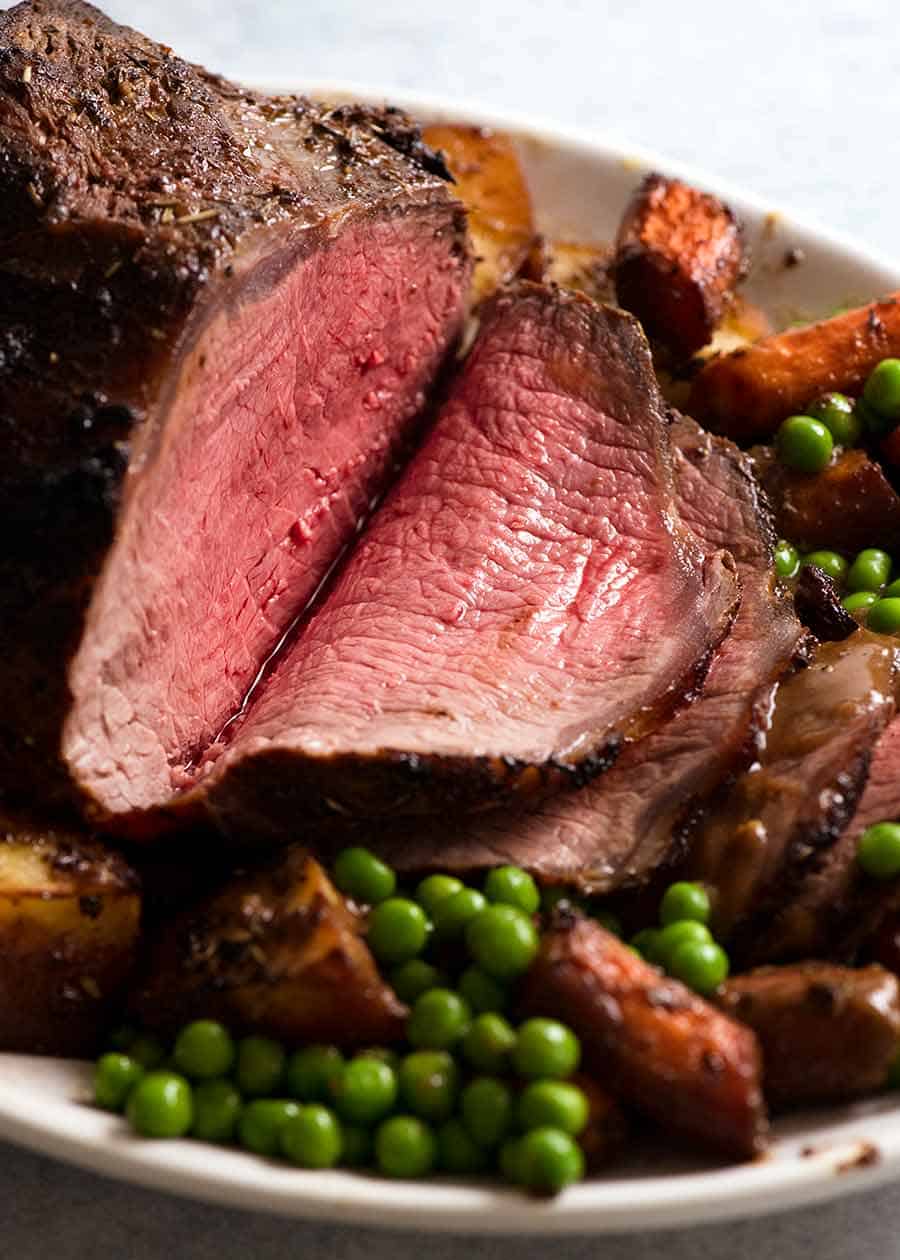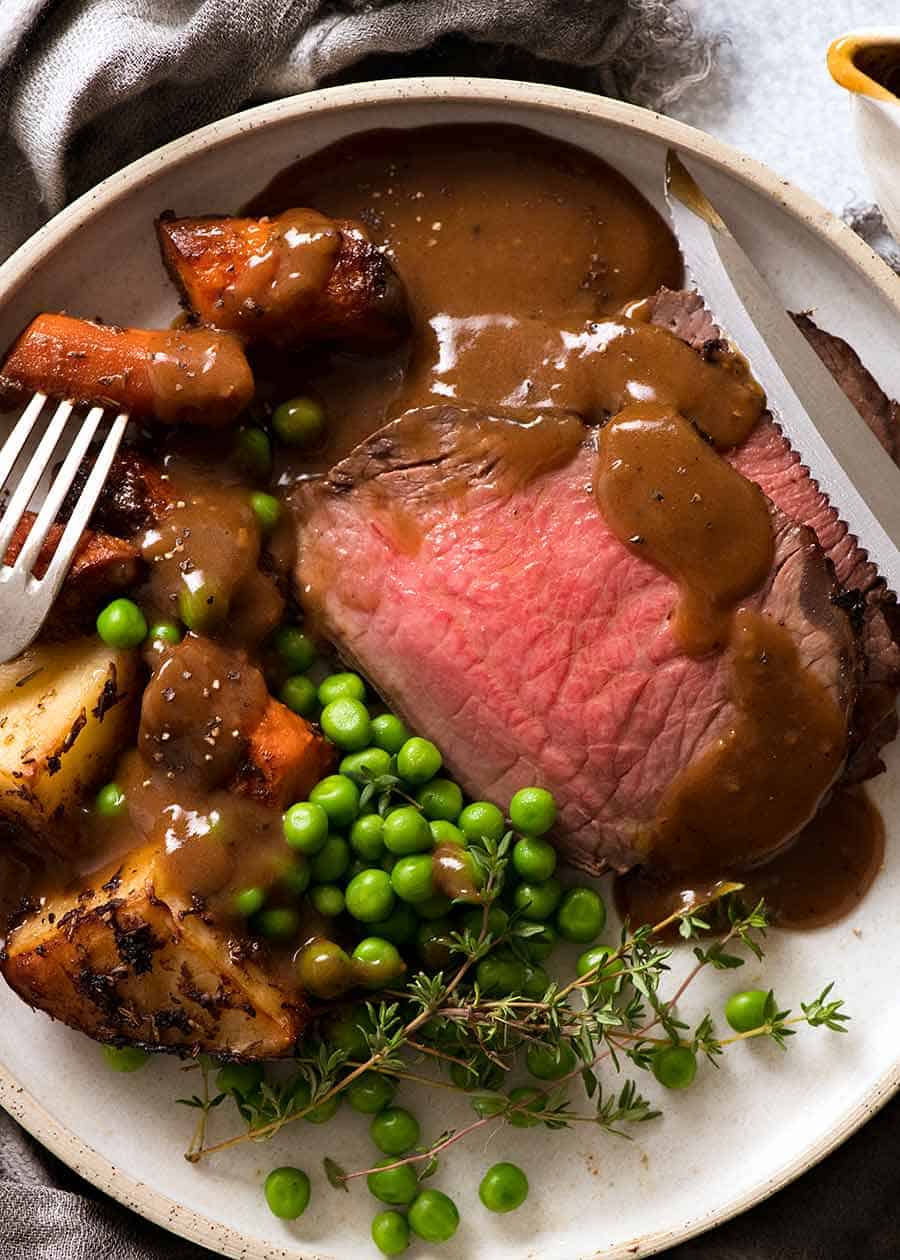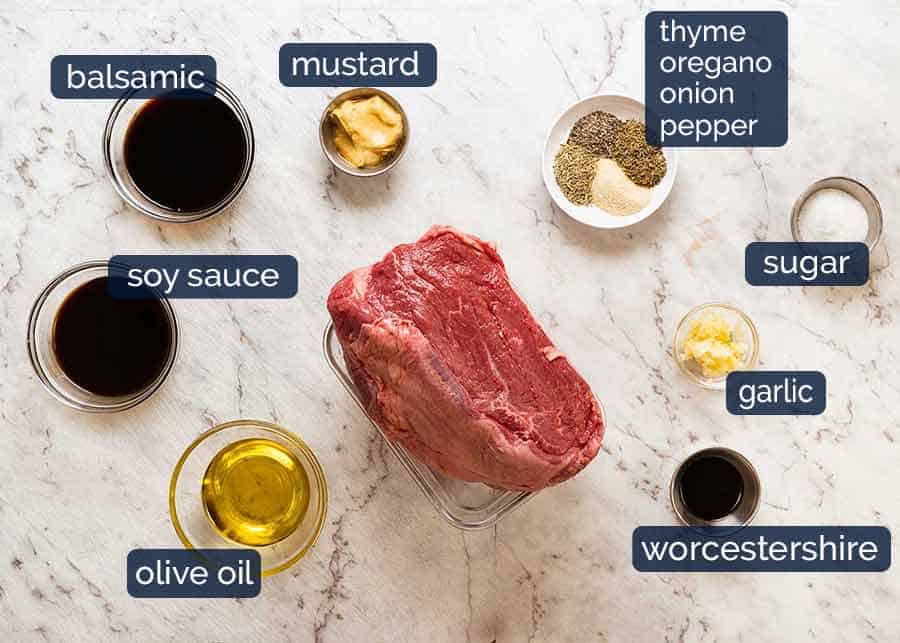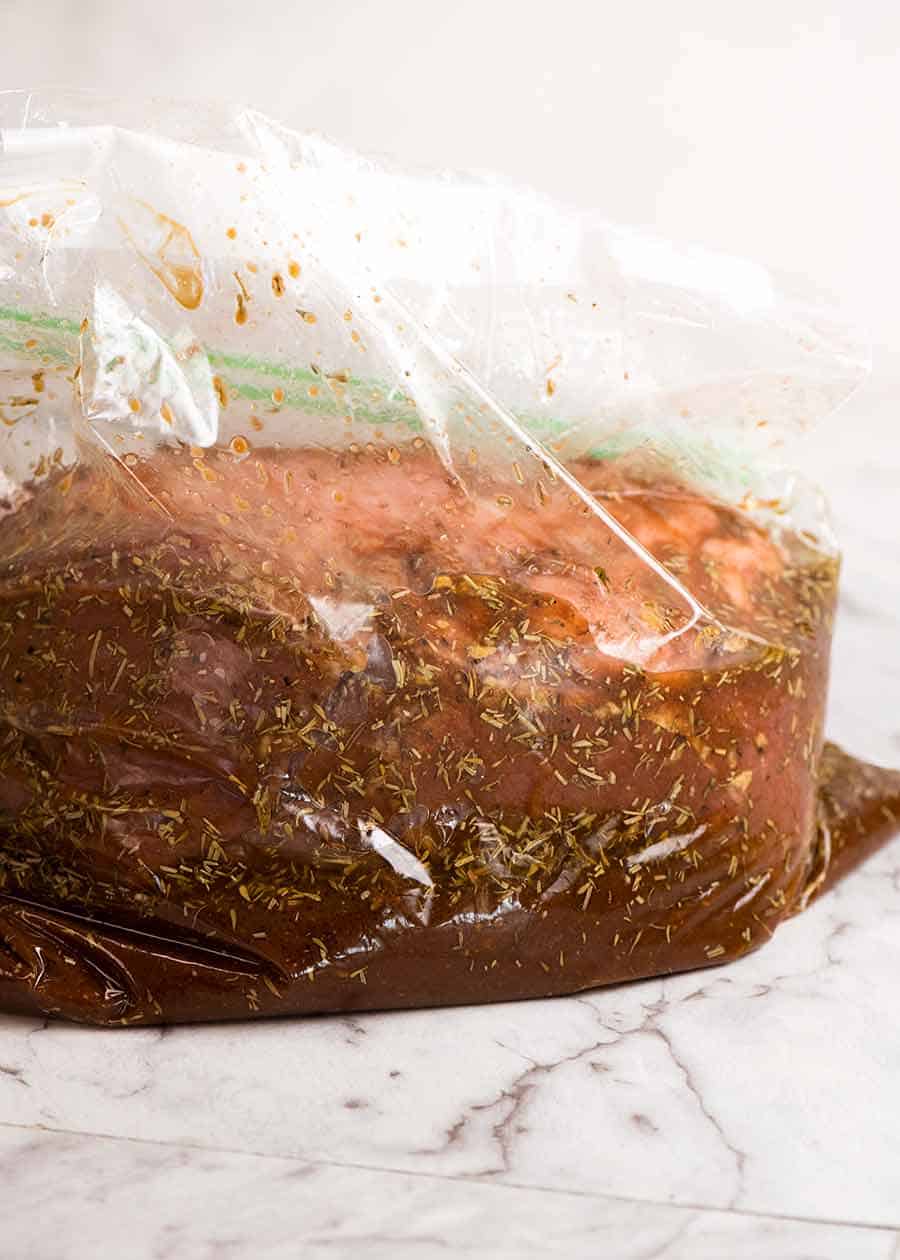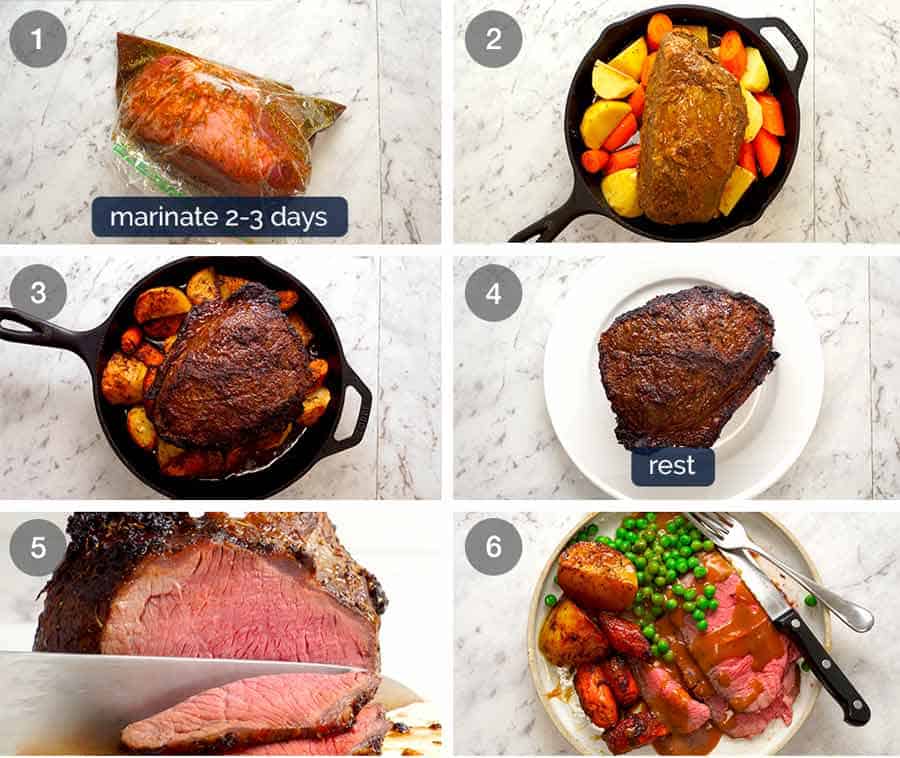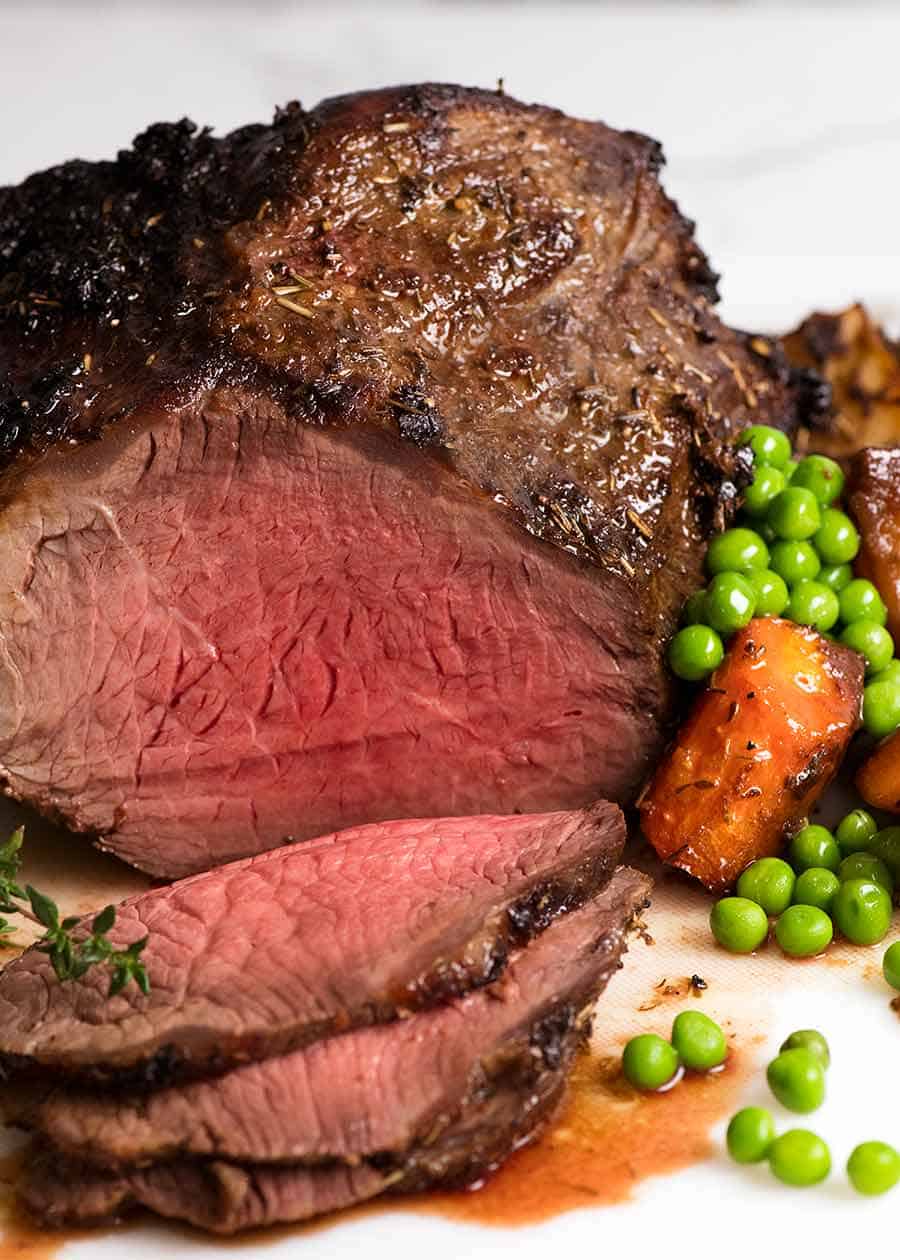** Follow the Roast Beef Cut guide below to determine which cuts are best for marinating**
Marinated Roast Beef
This is a recipe that was born during the days when I was a poverty stricken uni student who refused to live on packet ramen day after day. I wanted roast beef and gravy, damn it! But of course, my budget would never stretch to Prime Rib, so I’d purchase the best value roast beef cuts I could find then end up chewing my way through dry, tasteless roast beef. Because that is, after all, the reason we pay top dollar for premium cuts – it’s tender, juicy and full of flavour. So I started marinating the economical beef I purchased, to add flavour and juiciness. And I never stopped! 🙂
Use this roast beef marinade for economical roast beef cuts to add flavour and juiciness!
Roast Beef Marinade ingredients
Here’s what you need. The ingredients in this are pretty similar to my Steak Marinade. It’s a great one for beef because it adds savoury flavour without overwhelming ie it complements and enhances the beef flavour, rather than overtaking it completely. (PS Soy sauce acts as a brine in this recipe, injecting salt into the flesh. As opposed to adding Asian flavours – there is nothing remotely Asian about this roast beef recipe!
Best Roast Beef Cuts
Use this recipe on any economical beef roast cut. It would be wasted on expensive cuts, so do not use it on Prime Rib, beef tenderloin or any cut of roast beef that you’ve paid top dollar for. Here’s a list of some of the most common roast beef cuts – I’ve done my best to translate the name of cuts between Australia, the US and UK!
Great for this roast beef marinade
Oyster Blade Roast (Aus) / Top Blade Roast (US) – great for this marinade! Pretty tender cut with decent flavour, very good value. Looks like the pictured roast beef but has a thin line of membrane in the middle. Bolar Blade (Aus/parts of UK) – perfect for this marinade! An economical cut with fair flavour and is reasonably tender but is enhanced by marinading. This is pictured in the post and video. This cut doesn’t really exist in the US, it’s part of the cow shoulder gets mixed up in chuck meat. Eye of Round Roast (US) / Girello (Australia) – ideal for this marinade because it’s a leaner, tougher cut of meat with less beefy flavour. In Australia, this cut of beef is usually sold in medallion steak form or pre marinated at supermarkets, so it’s not really available. Silverside (Aus/UK) / Bottom Round Roast (US) – this is one of the tougher cuts of roast beef, usually slow cooked. It’s used for corned beef and to make things like Pastrami. This marinade is ideal for adding flavour to this cut and it can be cooked to pink as pictured, as long as the beef is sliced very thinly.
Optional Marinade
Rump Roast (Aust) / Top Sirloin Roast (US) – tender, juicy and marbled and a good quality one doesn’t need marinating BUT if you get a very economical one, it will certainly benefit from marinading. Topside Roast (Aus/UK name) / Top Round Roast (US) – probably the most popular cut for a classic roast beef (ie not marinated). If you’ve purchased a good quality one, there’s no need to marinade. But if you’ve purchased a good value one, this roast beef marinade will certainly enhance it.
Do not use marinade for these beef cuts
Tender, juicy, prime beef cuts – Prime rib / standing rib roast, scotch fillet roast (which is standing rib minus the bone), tenderloin, strip loin roast / Porterhouse roast. These are pricier, quality cuts and a marinade would be wasted on them! Slow cooking cuts – Brisket, chuck and ribs. These are tough cuts of beef that need to be slow cooked to breakdown the tough fibres. Because of this, I typically do not marinade them as the slow cooking time is when the flavour is infused into the beef – recipes like Pot Roast, Beef Stew, Short Ribs in Red Wine Sauce and Brisket in BBQ Sauce.
How to make it
The making part is very straight forward – marinade, plonk on veggies and roast on high (240C/450F) to get a nice crust, then turn down to 180C/350F to finish cooking. MOST IMPORTANT STEP is to rest the beef for a minimum of 20 minutes, ideally 30 minutes, to allow the juices to get sucked back into the beef. If you do not rest, the meat juices will run everywhere the second you cut it = less juicy beef. 😢 Because we’re talking about a piece of meat that’s somewhat larger than chicken breast, you’ll get the best results if you can marinate for 2 to 3 days. Anything less than 24 hours is better than not marinating at all, but it’s less effective.
Final Tips!
Take the beef out of the fridge 1 hour prior – key to take the chill out of the core a bit to encourage even cooking Slice thinly against the grain – No matter what cut of beef you are using, slice the beef thinly against the grain for the most tender bite. Here’s a diagram for how to slice against the grain – just look for the direction of the meat fibres and cut 90° across them. Start high, then go low(ish) – this recipe starts high at 240C/450F to get the crust going, then finishes roasting at 180C/350F until it’s perfectly pink and super juicy inside. Roast on veggies OR a rack – this encourages more even cooking of the roast by elevating it off the base of the pan (well, skillet in my case. Handy to make gravy afterwards rather than man handling a roasting pan on the stove 😇).
You can just use a rack, I personally think anyone would be made to turn down tasty roasted veg that have sucked up the flavour of the marinade AND been basted with juices from the roast beef, but who am I to judge? 🤷🏻♀️
Gravy is optional here – we’ve added good flavour into the beef so you don’t need it. But I’m never one to turn down gravy, so I’ve popped the recipe in the notes. But truly, it’s great even without. This beef is so juicy, it is literally squirting juices everywhere when you cut into it – and that’s even after resting it for a good 30 minutes. I really hope I managed to capture how tender and juicy the beef is in the recipe video! – Nagi x
Watch how to make it
Life of Dozer
1 dog 1 rug Fills the vacuum cleaner twice every week SO. MUCH. FUR!!!🙄
